Conghao Zhou
Tony
QoE-Aware Service Provision for Mobile AR Rendering: An Agent-Driven Approach
Aug 12, 2025Abstract:Mobile augmented reality (MAR) is envisioned as a key immersive application in 6G, enabling virtual content rendering aligned with the physical environment through device pose estimation. In this paper, we propose a novel agent-driven communication service provisioning approach for edge-assisted MAR, aiming to reduce communication overhead between MAR devices and the edge server while ensuring the quality of experience (QoE). First, to address the inaccessibility of MAR application-specific information to the network controller, we establish a digital agent powered by large language models (LLMs) on behalf of the MAR service provider, bridging the data and function gap between the MAR service and network domains. Second, to cope with the user-dependent and dynamic nature of data traffic patterns for individual devices, we develop a user-level QoE modeling method that captures the relationship between communication resource demands and perceived user QoE, enabling personalized, agent-driven communication resource management. Trace-driven simulation results demonstrate that the proposed approach outperforms conventional LLM-based QoE-aware service provisioning methods in both user-level QoE modeling accuracy and communication resource efficiency.
Drift-Adaptive Slicing-Based Resource Management for Cooperative ISAC Networks
Jun 25, 2025Abstract:In this paper, we propose a novel drift-adaptive slicing-based resource management scheme for cooperative integrated sensing and communication (ISAC) networks. Particularly, we establish two network slices to provide sensing and communication services, respectively. In the large-timescale planning for the slices, we partition the sensing region of interest (RoI) of each mobile device and reserve network resources accordingly, facilitating low-complexity distance-based sensing target assignment in small timescales. To cope with the non-stationary spatial distributions of mobile devices and sensing targets, which can result in the drift in modeling the distributions and ineffective planning decisions, we construct digital twins (DTs) of the slices. In each DT, a drift-adaptive statistical model and an emulation function are developed for the spatial distributions in the corresponding slice, which facilitates closed-form decision-making and efficient validation of a planning decision, respectively. Numerical results show that the proposed drift-adaptive slicing-based resource management scheme can increase the service satisfaction ratio by up to 18% and reduce resource consumption by up to 13.1% when compared with benchmark schemes.
Intelligent Polarforming Antenna Enhanced Sensing and Communication: Modeling and Optimization
May 12, 2025Abstract:In this paper, we propose a novel intelligent polarforming antenna (IPA) to achieve cost-effective wireless sensing and communication. Specifically, the IPA can enable polarforming by adaptively controlling the antenna's polarization electrically as well as its position/rotation mechanically, so as to effectively exploit polarization and spatial diversity to reconfigure wireless channels for improving sensing and communication performance. We study an IPA-enhanced integrated sensing and communication (ISAC) system that utilizes user location sensing to facilitate communication between an IPA-equipped base station (BS) and IPA-equipped users. First, we model the IPA channel in terms of transceiver antenna polarforming vectors and antenna positions/rotations. We then propose a two-timescale ISAC protocol, where in the slow timescale, user localization is first performed, followed by the optimization of the BS antennas' positions and rotations based on the sensed user locations; subsequently, in the fast timescale, transceiver polarforming is adapted to cater to the instantaneous channel state information (CSI), with the optimized BS antennas' positions and rotations. We propose a new polarforming-based user localization method that uses a structured time-domain pattern of pilot-polarforming vectors to extract the common stable components in the IPA channel across different polarizations based on the parallel factor (PARAFAC) tensor model. Moreover, we maximize the achievable average sum-rate of users by jointly optimizing the fast-timescale transceiver polarforming, including phase shifts and amplitude variations, along with the slow-timescale antenna rotations and positions at the BS. Simulation results validate the effectiveness of polarforming-based localization algorithm and demonstrate the performance advantages of polarforming, antenna placement, and their joint design.
QoE-oriented Communication Service Provision for Annotation Rendering in Mobile Augmented Reality
Jan 13, 2025


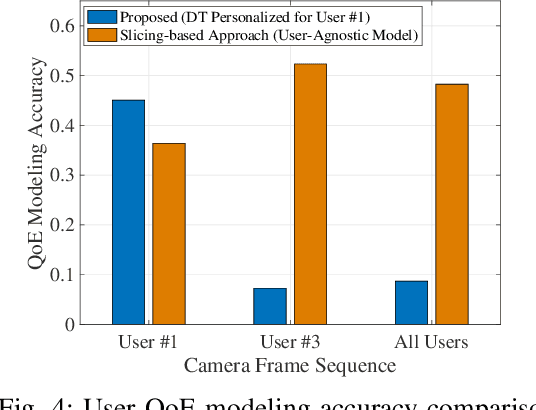
Abstract:As mobile augmented reality (MAR) continues to evolve, future 6G networks will play a pivotal role in supporting immersive and personalized user experiences. In this paper, we address the communication service provision problem for annotation rendering in edge-assisted MAR, with the objective of optimizing spectrum resource utilization while ensuring the required quality of experience (QoE) for MAR users. To overcome the challenges of user-specific uplink data traffic patterns and the complex operational mechanisms of annotation rendering, we propose a digital twin (DT)-based approach. We first design a DT specifically tailored for MAR applications to learn key annotation rendering mechanisms, enabling the network controller to access MAR application-specific information. Then, we develop a DT based QoE modeling approach to capture the unique relationship between individual user QoE and spectrum resource demands. Finally, we propose a QoE-oriented resource allocation algorithm that decreases resource utilization compared to conventional net work slicing-based approaches. Simulation results demonstrate that our DT-based approach outperforms benchmark approaches in the accuracy and granularity of QoE modeling.
User-centric Immersive Communications in 6G: A Data-oriented Approach via Digital Twin
Oct 03, 2024



Abstract:In this article, we present a novel user-centric service provision for immersive communications (IC) in 6G to deal with the uncertainty of individual user behaviors while satisfying unique requirements on the quality of multi-sensory experience. To this end, we propose a data-oriented approach for network resource management, featuring personalized data management that can support network modeling tailored to different user demands. Our approach leverages the digital twin (DT) technique as a key enabler. Particularly, a DT is established for each user, and the data attributes in the DT are customized based on the characteristics of the user. The DT functions, corresponding to various data operations, are customized in the development, evaluation, and update of network models to meet unique user demands. A trace-driven case study demonstrates the effectiveness of our approach in achieving user-centric IC and the significance of personalized data management in 6G.
Digital Twin-Based User-Centric Edge Continual Learning in Integrated Sensing and Communication
Nov 20, 2023



Abstract:In this paper, we propose a digital twin (DT)-based user-centric approach for processing sensing data in an integrated sensing and communication (ISAC) system with high accuracy and efficient resource utilization. The considered scenario involves an ISAC device with a lightweight deep neural network (DNN) and a mobile edge computing (MEC) server with a large DNN. After collecting sensing data, the ISAC device either processes the data locally or uploads them to the server for higher-accuracy data processing. To cope with data drifts, the server updates the lightweight DNN when necessary, referred to as continual learning. Our objective is to minimize the long-term average computation cost of the MEC server by optimizing two decisions, i.e., sensing data offloading and sensing data selection for the DNN update. A DT of the ISAC device is constructed to predict the impact of potential decisions on the long-term computation cost of the server, based on which the decisions are made with closed-form formulas. Experiments on executing DNN-based human motion recognition tasks are conducted to demonstrate the outstanding performance of the proposed DT-based approach in computation cost minimization.
User Dynamics-Aware Edge Caching and Computing for Mobile Virtual Reality
Nov 17, 2023



Abstract:In this paper, we present a novel content caching and delivery approach for mobile virtual reality (VR) video streaming. The proposed approach aims to maximize VR video streaming performance, i.e., minimizing video frame missing rate, by proactively caching popular VR video chunks and adaptively scheduling computing resources at an edge server based on user and network dynamics. First, we design a scalable content placement scheme for deciding which video chunks to cache at the edge server based on tradeoffs between computing and caching resource consumption. Second, we propose a machine learning-assisted VR video delivery scheme, which allocates computing resources at the edge server to satisfy video delivery requests from multiple VR headsets. A Whittle index-based method is adopted to reduce the video frame missing rate by identifying network and user dynamics with low signaling overhead. Simulation results demonstrate that the proposed approach can significantly improve VR video streaming performance over conventional caching and computing resource scheduling strategies.
* 38 pages, 13 figures, single column double spaced, published in IEEE Journal of Selected Topics in Signal Processing
Effectively Heterogeneous Federated Learning: A Pairing and Split Learning Based Approach
Aug 26, 2023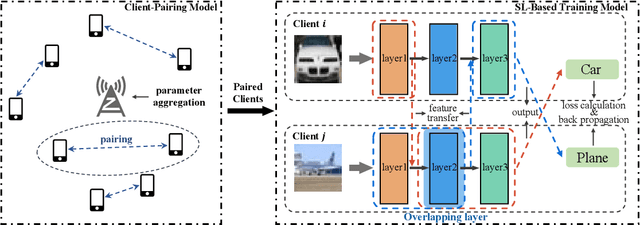
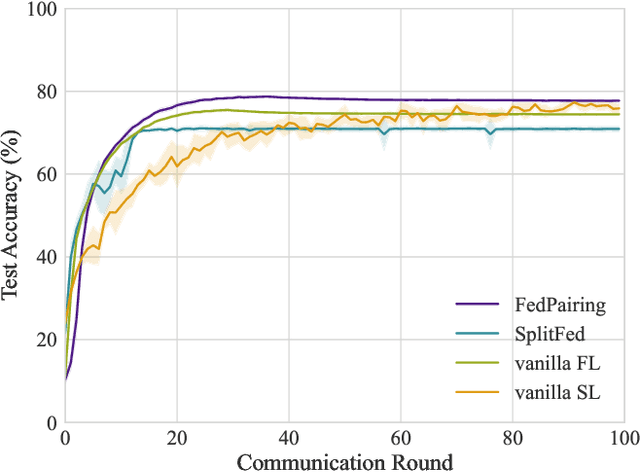
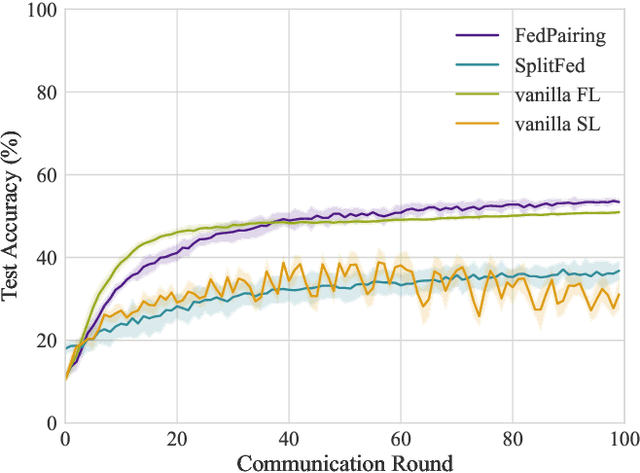

Abstract:As a promising paradigm federated Learning (FL) is widely used in privacy-preserving machine learning, which allows distributed devices to collaboratively train a model while avoiding data transmission among clients. Despite its immense potential, the FL suffers from bottlenecks in training speed due to client heterogeneity, leading to escalated training latency and straggling server aggregation. To deal with this challenge, a novel split federated learning (SFL) framework that pairs clients with different computational resources is proposed, where clients are paired based on computing resources and communication rates among clients, meanwhile the neural network model is split into two parts at the logical level, and each client only computes the part assigned to it by using the SL to achieve forward inference and backward training. Moreover, to effectively deal with the client pairing problem, a heuristic greedy algorithm is proposed by reconstructing the optimization of training latency as a graph edge selection problem. Simulation results show the proposed method can significantly improve the FL training speed and achieve high performance both in independent identical distribution (IID) and Non-IID data distribution.
AI-Assisted Slicing-Based Resource Management for Two-Tier Radio Access Networks
Aug 21, 2023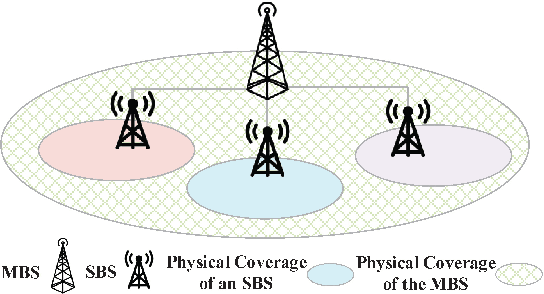
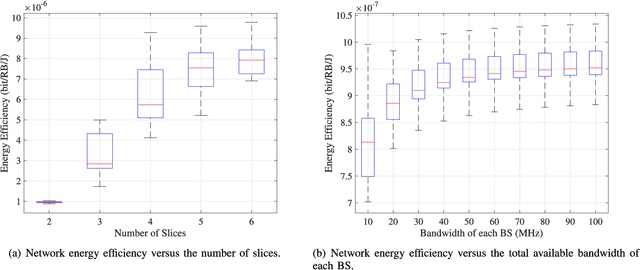
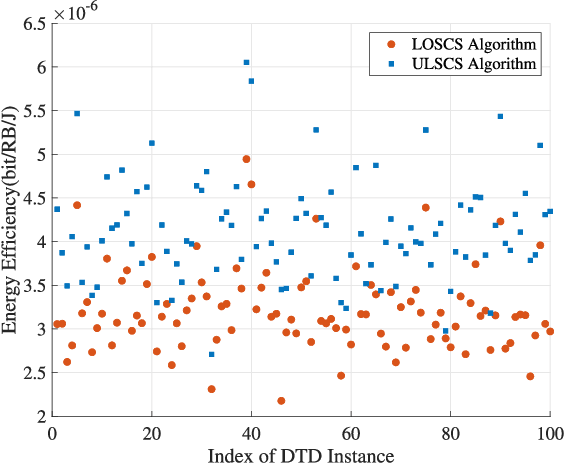
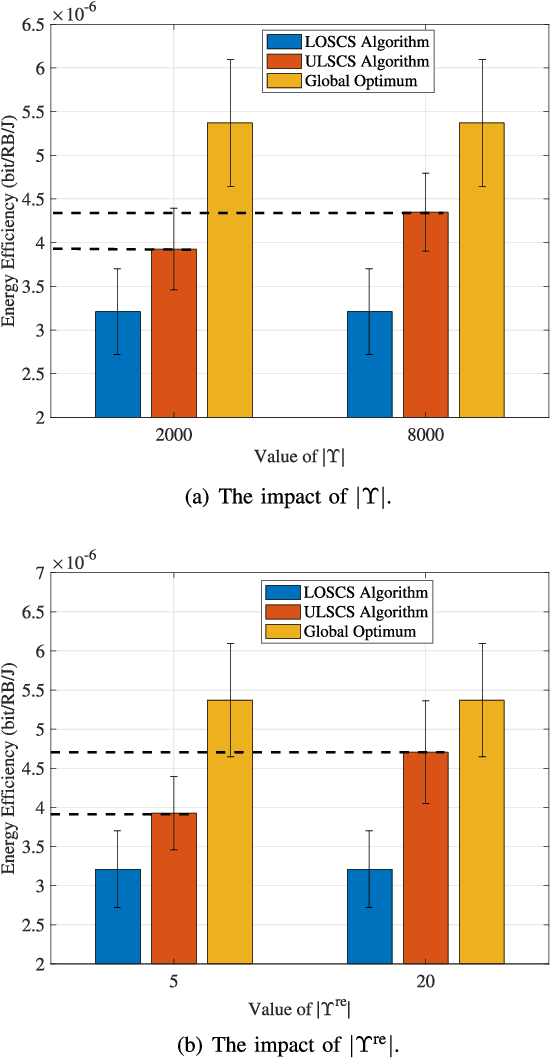
Abstract:While network slicing has become a prevalent approach to service differentiation, radio access network (RAN) slicing remains challenging due to the need of substantial adaptivity and flexibility to cope with the highly dynamic network environment in RANs. In this paper, we develop a slicing-based resource management framework for a two-tier RAN to support multiple services with different quality of service (QoS) requirements. The developed framework focuses on base station (BS) service coverage (SC) and interference management for multiple slices, each of which corresponds to a service. New designs are introduced in the spatial, temporal, and slice dimensions to cope with spatiotemporal variations in data traffic, balance adaptivity and overhead of resource management, and enhance flexibility in service differentiation. Based on the proposed framework, an energy efficiency maximization problem is formulated, and an artificial intelligence (AI)-assisted approach is proposed to solve the problem. Specifically, a deep unsupervised learning-assisted algorithm is proposed for searching the optimal SC of the BSs, and an optimization-based analytical solution is found for managing interference among BSs. Simulation results under different data traffic distributions demonstrate that our proposed slicing-based resource management framework, empowered by the AI-assisted approach, outperforms the benchmark frameworks and achieves a close-to-optimal performance in energy efficiency.
Digital Twin-Based 3D Map Management for Edge-Assisted Mobile Augmented Reality
May 26, 2023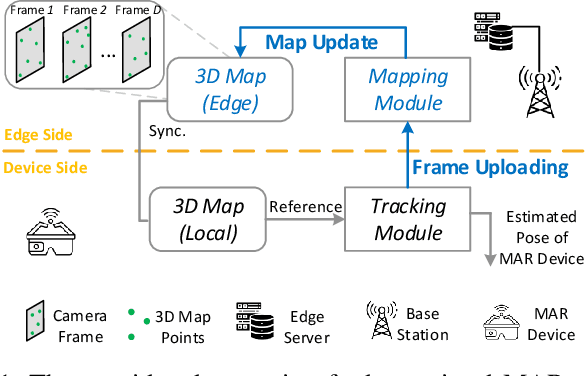
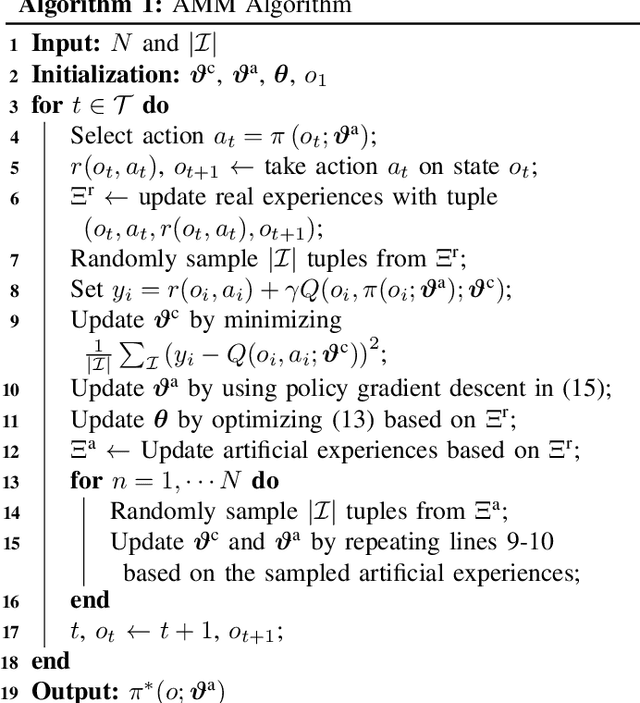
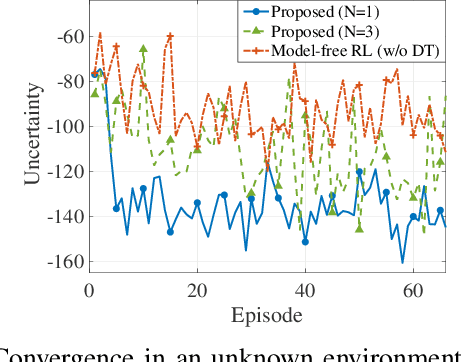
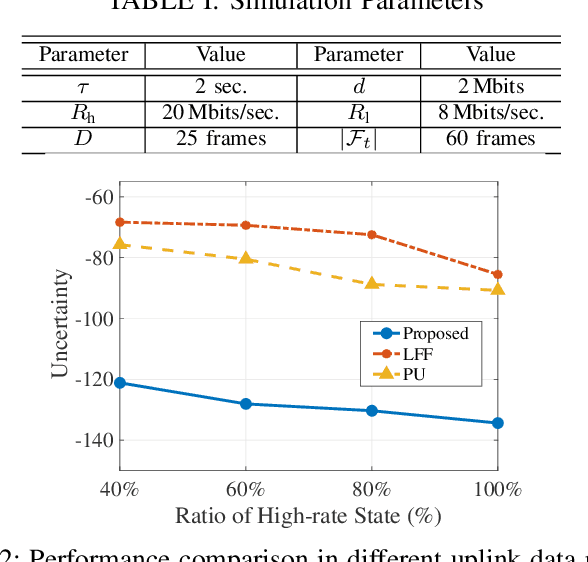
Abstract:In this paper, we design a 3D map management scheme for edge-assisted mobile augmented reality (MAR) to support the pose estimation of individual MAR device, which uploads camera frames to an edge server. Our objective is to minimize the pose estimation uncertainty of the MAR device by periodically selecting a proper set of camera frames for uploading to update the 3D map. To address the challenges of the dynamic uplink data rate and the time-varying pose of the MAR device, we propose a digital twin (DT)-based approach to 3D map management. First, a DT is created for the MAR device, which emulates 3D map management based on predicting subsequent camera frames. Second, a model-based reinforcement learning (MBRL) algorithm is developed, utilizing the data collected from both the actual and the emulated data to manage the 3D map. With extensive emulated data provided by the DT, the MBRL algorithm can quickly provide an adaptive map management policy in a highly dynamic environment. Simulation results demonstrate that the proposed DT-based 3D map management outperforms benchmark schemes by achieving lower pose estimation uncertainty and higher data efficiency in dynamic environments.
 Add to Chrome
Add to Chrome Add to Firefox
Add to Firefox Add to Edge
Add to Edge